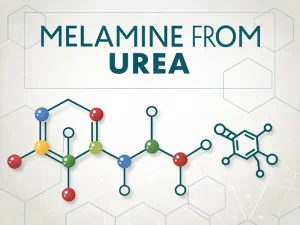
Melamine Packaging
Tech Blog Melamine packaging For manufacturers, inaccurate packaging not only fails to meet national standards but also increases labor costs and the risk of product

Urea is a simple organic compound with the chemical formula CO (NH₂)₂, and is one of the most widely produced chemicals in the world. Its most well-known use is as fertilizer, but its application range has also expanded to plastics, adhesives, animal feed, and even cosmetics. Methanol is the simplest alcohol, a widely used solvent, and a crucial basic raw material in the chemical industry.
For researchers and production practitioners, a key technical question is: What is the solubility of urea in methanol? How can this feature be applied in practical production?
The solubility of urea in methanol is crucial for various applications:
Urea formaldehyde resin (UFR): During the production process of UFR, urea reacts with formaldehyde. Methanol is typically used as a solvent or byproduct, and understanding urea’s behaviour in a methanol medium is crucial for controlling reaction kinetics and product properties.
Special fertilizers: Some liquid or suspended fertilizers may use methanol as an ingredient or processing aid, which requires an understanding of the solubility characteristics of urea.
Chemical synthesis: In various organic synthesis reactions, urea is used as a reactant or product, and methanol is used as a solvent. Its solubility determines the reaction efficiency, purification method, and yield.
Analytical Chemistry: For specific analytical techniques or quality control measurements involving urea, methanol can be used as a solvent.
Room temperature (about 20-25 ° C): According to reports, the solubility of urea in methanol is generally 15-25 grams per 100 millilitres of methanol.
Temperature increase: As the temperature rises, this value increases significantly. For example, at higher temperatures (such as 60-70 ° C), solubility will increase substantially, allowing for the preparation of solutions with higher concentrations.
Note: These are approximate values. For precise industrial applications, it is recommended to always refer to specific phase diagrams or conduct experimental measurements under actual operating conditions.
It is worth noting that the solubility of urea in water is much higher than its solubility in methanol. At 20 ℃, the solubility of urea in water is about 108 grams/100 millilitres, significantly higher than its solubility in methanol. This difference is due to the stronger hydrogen-bonding network formed between water molecules and urea than between methanol molecules.
As mentioned earlier, temperature is positively correlated with solubility. This is because high temperatures can provide more energy, breaking the intermolecular forces within urea crystals and making it easier for urea molecules to interact with and disperse into methanol molecules.
In industrial production, the cycle of “heating dissolution cooling crystallization” can separate urea from impurities with lower solubility in methanol, achieving purification.
Impurities in methanol, such as water, ethanol, and acetone, can significantly alter urea’s solubility.
The influence of moisture: Even a small amount of moisture (such as 5% by volume) can increase the solubility of urea. The stronger hydrogen-bonding ability of water molecules synergises with that of methanol, creating a more favourable environment for urea dissolution.
The influence of non-polar impurities: Non-polar substances such as n-hexane and toluene (common impurities in industrial methanol) can reduce solubility. These molecules can break hydrogen bonds between methanol and urea, hindering urea’s dissolution.
Therefore, for industrial applications that require high solubility accuracy (such as pharmaceutical synthesis), anhydrous methanol (<0.1% moisture) must be used.
Unlike gases (whose solubility increases with pressure), urea is a solid, and pressure has little effect on its solubility in methanol. Even in high-pressure environments, the solubility change does not exceed 2%. Therefore, in most practical applications, pressure can be considered as an irrelevant factor.
Fine-ground urea dissolves faster in methanol than large particle urea. Still, it does not increase the maximum solubility (the total amount of urea that can be dissolved at a certain temperature).
Small particles have a larger specific surface area, allowing more urea molecules to come into contact with methanol simultaneously, thereby accelerating dissolution without changing the equilibrium state of dissolution.
This method determines solubility by dissolving urea in methanol to saturation (no longer dissolved) and measuring the amount of dissolved urea.
Operation steps:
Add a known volume of methanol (e.g. 100 mL) to a flask equipped with a stirrer and temperature controller;
Gradually add urea crystals while stirring until undissolved urea appears at the bottom (even after stirring for 1-2 hours), at which point the solution reaches saturation;
Filter the solution to remove undissolved urea and collect the filtrate sample.
Determine the amount of dissolved urea in the filtrate using high-performance liquid chromatography (HPLC) or total nitrogen analysis (urea contains 46% nitrogen).
Advantages: High accuracy (error < 1%), suitable for determining equilibrium solubility. Disadvantages: It takes a long time (several hours to reach equilibrium) and is not ideal for rapid on-site testing.
The dynamic method calculates solubility by tracking the temperature at which urea begins to crystallize as a heated saturated solution cools.
Operation steps:
Heat methanol to the target temperature (such as 60 ℃), add urea until completely dissolved, and form a saturated solution;
Slowly cool the solution while stirring, and record the temperature at which urea crystals first appear.
By using pre-calibrated charts (or software), correlate crystallisation temperature with solubility (e.g., crystallisation occurs at 30 ℃, corresponding to a solubility of approximately 18 g/100 mL).
Advantages: Fast speed (completed in 30-60 minutes), suitable for process control in industrial sites; Disadvantages: The accuracy is lower than that of the static equilibrium method (with an error of 3% -5%), relying on precise temperature measurement.
The solubility of urea in methanol is not a theoretical concept in the laboratory, but a core characteristic that supports key processes in multiple industrial fields. The following are the most influential application scenarios:
Crude urine synthesized in industry often contains impurities such as ammonium carbamate, urea, and unreacted ammonia. Methanol can be purified from urea by the recrystallization method:
Step 1: Mix crude urea with methanol and heat to 60 ℃. Dissolve urea (impurities such as biuret have low solubility and remain in solid form);
Step 2: Filter the solution to remove impurities.
Step 3: Cool the filtrate to 20 ℃, and urea crystals precipitate, and soluble impurities remain in methanol.
Step 4: Collect and dry urea crystals to obtain high-purity products (such as pharmaceutical-grade urea).
Urea and methanol can form a 1:1 molar solid adduct (bonded by hydrogen bonds). The adduct is stable at low temperatures (<10 ℃) and decomposes upon heating.
The applications of this feature include:
Natural gas processing: Urea methanol adduct can absorb moisture and sulfur-containing compounds from natural gas, purifying natural gas (used for fuel or raw materials).
Low temperature storage: When heated, the adduct releases methanol, which can be used as a “slow-release methanol source” for portable fuel cells.
Methanol is a commonly used solvent in pharmaceutical manufacturing, and the solubility of urea in methanol provides the possibility for specific drug synthesis:
For example, in the methanol system, urea can be used to prepare barbiturates (sedatives) and urea compounds (anti-inflammatory drugs). Controllable solubility ensures uniform mixing of reactants, and excess urea can be easily removed by cooling crystallisation.
Some industrial wastewater (such as fertiliser plant wastewater) contains high concentrations of urea. Methanol can be used to recover urea from sewage:
Mix wastewater with methanol, then heat to dissolve urea.
After filtering to remove solid impurities, the solution is cooled, and urea crystals precipitate and are collected, while methanol is recycled for reuse. This process not only reduces waste emissions but also recovers valuable urea.
The solubility of urea in methanol is a fundamental physicochemical property that underpins various industrial and chemical processes. Although the solubility of urea in methanol is lower than its solubility in water, it still has good solubility in methanol, and its solubility is significantly affected by temperature.
Understanding these characteristics helps precisely control reaction conditions, efficiently generate products, and develop effective purification strategies, with applications ranging from resin manufacturing to speciality chemical synthesis and beyond. With continuous innovation in various industries, a precise understanding of these basic chemical properties remains crucial.

Tech Blog Melamine packaging For manufacturers, inaccurate packaging not only fails to meet national standards but also increases labor costs and the risk of product

Tech Blog How to Detect Melamine in Textiles? Melamine powder, a nitrogen-containing heterocyclic compound, is widely used in flame-retardant textiles and plastic products due to

Tech Blog melamine from urea Melamine is well-known for its wide range of applications, but its raw material for production is surprisingly urea. For manufacturers,

JINGJIANG MELAMINE POWDER
© JINJIANG MELAMINE